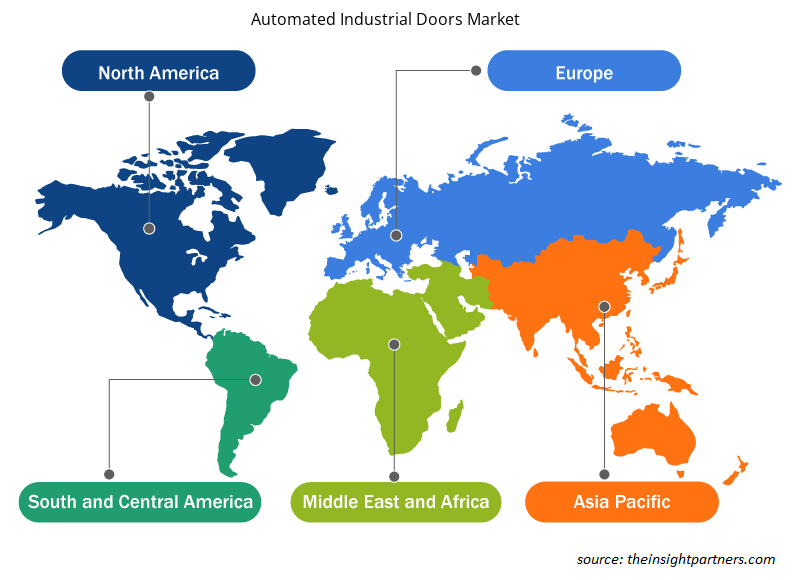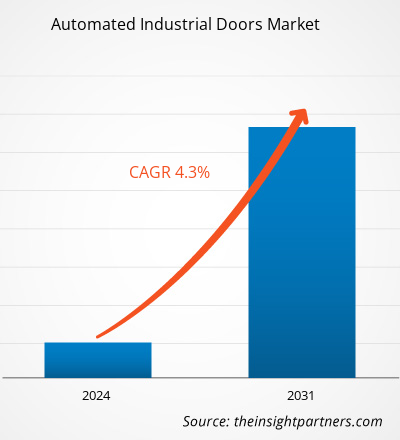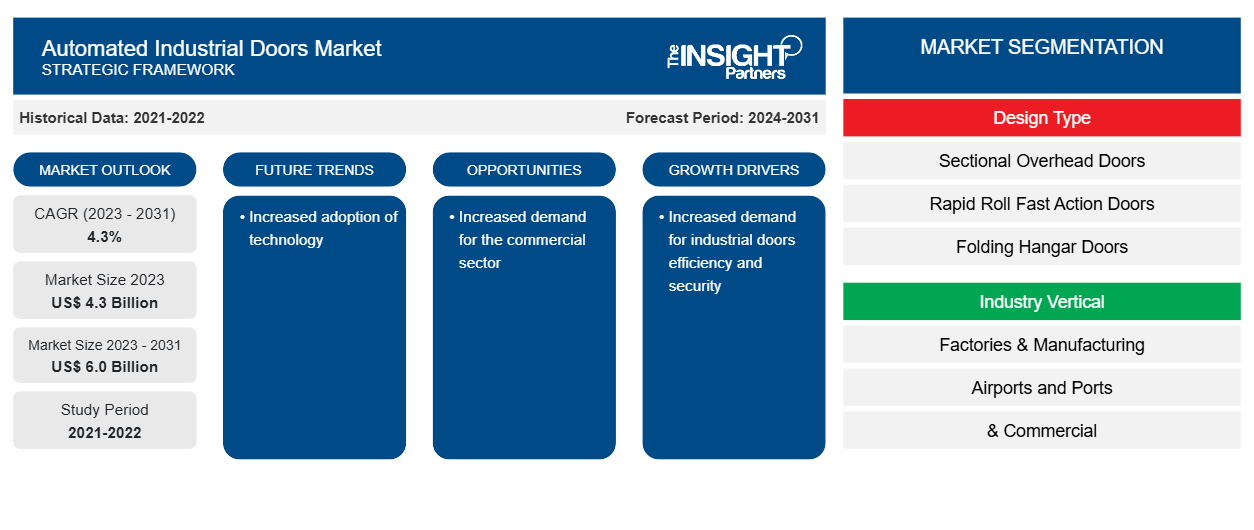Der Markt für automatisierte Industrietüren soll von 4,3 Milliarden US-Dollar im Jahr 2023 auf 6,0 Milliarden US-Dollar im Jahr 2031 anwachsen. Der Markt soll in den Jahren 2023–2031 eine durchschnittliche jährliche Wachstumsrate (CAGR) von 4,3 % verzeichnen. Einer der jüngsten Trends in der Branche ist die zunehmende Einführung von Technologien wie sensorbasierten Systemen, berührungslosen Bedienvorgängen und biometrischer Erkennung. Da die Trends der IoT -Technologie und intelligenter Fabriken zunehmen, steigt auch die Einführung technologisch fortschrittlicher Produkte.
Marktanalyse für automatisierte Industrietore
Die steigende Zahl kommerzieller Infrastrukturen ist einer der bemerkenswerten Faktoren für das Wachstum des Marktes für Industrietore weltweit. Die Zahl der Flughäfen weltweit nimmt erheblich zu. Daher steigt auch die Zahl der automatisierten Industrietore. Laut den von der US-Regierung im Jahr 2023 veröffentlichten Daten gibt es in den USA etwa 5000 Flughäfen. Die US-Regierung ergreift jedoch verschiedene Initiativen, um die derzeitige Zahl der Flughäfen zu erhöhen und bestehende Flughäfen zu erweitern und zu renovieren. Aufgrund dieser Faktoren steigt die Nachfrage nach automatisierten Industrietoren erheblich an, was letztlich den Markt antreibt.
Marktübersicht für automatisierte Industrietüren
Aufgrund der Bauart werden Sektionaltore aufgrund einer Vielzahl von Faktoren voraussichtlich den Markt anführen. Einer der Hauptvorteile ist, dass diese Tore individuell anpassbar sind und in jeden Türrahmen passen. Darüber hinaus sind diese Tore auch für kleinere Räume geeignet. Aufgrund der oben genannten Vorteile ist die Nachfrage nach diesen automatischen Industrietoren gestiegen. In der Vergangenheit haben sich die Hersteller auf Produktentwicklung, Fusionen, Übernahmen und Geschäftserweiterungsstrategien konzentriert.
Passen Sie diesen Bericht Ihren Anforderungen an
Sie erhalten kostenlos individuelle Anpassungen an jedem Bericht, einschließlich Teilen dieses Berichts oder einer Analyse auf Länderebene, eines Excel-Datenpakets sowie tolle Angebote und Rabatte für Start-ups und Universitäten.
- Holen Sie sich die wichtigsten Markttrends aus diesem Bericht.Dieses KOSTENLOSE Beispiel umfasst eine Datenanalyse von Markttrends bis hin zu Schätzungen und Prognosen.
Markttreiber und Chancen für automatisierte Industrietore
Erhöhte Nachfrage nach Effizienz und Sicherheit für Industrietore
Die Nachfrage nach Industrietoren ist in den letzten Jahren gestiegen. Aufgrund des gestiegenen Bewusstseins für Nachhaltigkeit stieg jedoch auch die Nachfrage nach effizienten und effektiven automatisierten Industrietoren. Daher begannen Hersteller in der Branche, energieeffiziente Lösungen herzustellen und anzubieten . Mit der gestiegenen Nachfrage nach Energieeffizienz und dem starken Angebot der Hersteller in der Branche stieg also die Nachfrage nach automatisierten Industrietoren.
Erhöhte Nachfrage im kommerziellen Sektor
Da der gewerbliche Bausektor stark wächst, wird die Nachfrage nach automatisierten Industrietoren in den kommenden Jahren voraussichtlich stark ansteigen. Laut den Daten des American Institute of Architectures ( AIA ) aus dem Jahr 2023 stieg das Wachstum des gewerblichen Bausektors im Jahr 2023 im Vergleich zu 2022 um 20 %, und für 2024 wird für die Branche ein lukratives Wachstum erwartet. Darüber hinaus wird für Indiens Bausektor im Prognosezeitraum ein Wachstum von 10,7 % erwartet. Ein solches Wachstum des gewerblichen Bausektors wird voraussichtlich die Nachfrage nach dem automatisierten Industriesektor in den kommenden Jahren ankurbeln.
Segmentierungsanalyse des Marktberichts für automatisierte Industrietüren
Wichtige Segmente, die zur Ableitung der Marktanalyse für automatische Industrietüren beigetragen haben, sind Typ, Ursache, Störungstyp, Kategorie und Endbenutzer.
- Basierend auf dem Designtyp ist der Markt für automatisierte Industrietore in Sektionaltore, Schnelllauftore, Falttore für Hangars und andere unterteilt. Das Segment der Sektionaltore hatte im Jahr 2023 einen größeren Marktanteil.
- Nach Branchen ist der Markt in Fabriken und Fertigung, Flughäfen und Häfen sowie Gewerbe unterteilt. Das Segment Fabriken und Fertigung hatte im Jahr 2023 den größten Marktanteil.
Marktanteilsanalyse für automatisierte Industrietüren nach Geografie
Der geografische Umfang des Marktberichts über automatische Industrietüren ist hauptsächlich in fünf Regionen unterteilt: Nordamerika, Asien-Pazifik, Europa, Naher Osten und Afrika sowie Südamerika/Süd- und Mittelamerika.
Nordamerika dominiert den Markt für automatisierte Industrietüren. Einer der Faktoren hinter dem Marktwachstum ist die gestiegene Nachfrage nach dem entwickelten industriellen und expandierenden gewerblichen Bausektor in den USA. Darüber hinaus wird für den asiatisch-pazifischen Raum im Prognosezeitraum aufgrund des signifikanten Wachstums des industriellen Wachstums im Prognosezeitraum die höchste durchschnittliche jährliche Wachstumsrate (CAGR) erwartet. Laut den vom Internationalen Währungsfonds im Jahr 2022 veröffentlichten Daten verzeichnete der asiatisch-pazifische Raum im Vergleich zu 2021 ein Wachstum von 3,9 %. Darüber hinaus stieg das Wachstum im Jahr 2023 gegenüber 2022 um 4,6 %. Dieses Wachstum zeigt die kontinuierliche Ausweitung des industriellen Wachstums. Daher wird erwartet, dass ein verstärktes industrielles Wachstum lukrative Möglichkeiten für den Markt für automatisierte Industrietüren schafft.
Regionale Einblicke in den Markt für automatisierte Industrietüren
Die regionalen Trends und Faktoren, die den Markt für automatisierte Industrietüren im gesamten Prognosezeitraum beeinflussen, wurden von den Analysten von Insight Partners ausführlich erläutert. In diesem Abschnitt werden auch die Marktsegmente und die Geografie für automatisierte Industrietüren in Nordamerika, Europa, im asiatisch-pazifischen Raum, im Nahen Osten und Afrika sowie in Süd- und Mittelamerika erörtert.

- Erhalten Sie regionale Daten zum Markt für automatisierte Industrietüren
Umfang des Marktberichts über automatisierte Industrietüren
| Berichtsattribut | Details |
|---|---|
| Marktgröße im Jahr 2023 | 4,3 Milliarden US-Dollar |
| Marktgröße bis 2031 | 6,0 Milliarden US-Dollar |
| Globale CAGR (2023 - 2031) | 4,3 % |
| Historische Daten | 2021-2022 |
| Prognosezeitraum | 2024–2031 |
| Abgedeckte Segmente | Nach Designtyp
|
| Abgedeckte Regionen und Länder | Nordamerika
|
| Marktführer und wichtige Unternehmensprofile |
|
Marktteilnehmerdichte: Der Einfluss auf die Geschäftsdynamik
Der Markt für automatisierte Industrietüren wächst rasant, angetrieben durch die steigende Nachfrage der Endnutzer aufgrund von Faktoren wie sich entwickelnden Verbraucherpräferenzen, technologischen Fortschritten und einem größeren Bewusstsein für die Vorteile des Produkts. Mit steigender Nachfrage erweitern Unternehmen ihr Angebot, entwickeln Innovationen, um die Bedürfnisse der Verbraucher zu erfüllen, und nutzen neue Trends, was das Marktwachstum weiter ankurbelt.
Die Marktteilnehmerdichte bezieht sich auf die Verteilung von Firmen oder Unternehmen, die in einem bestimmten Markt oder einer bestimmten Branche tätig sind. Sie gibt an, wie viele Wettbewerber (Marktteilnehmer) in einem bestimmten Marktraum im Verhältnis zu seiner Größe oder seinem gesamten Marktwert präsent sind.
Die wichtigsten auf dem Markt für automatische Industrietüren tätigen Unternehmen sind:
- ASSA Abloy Entrance Systems AB
- Aufzeichnen
- Hart Türsysteme
- Gilgen Doors Systems
- Gandhi Automations Pvt. GmbH.
- Al BARRAK Industriegruppe
Haftungsausschluss : Die oben aufgeführten Unternehmen sind nicht in einer bestimmten Reihenfolge aufgeführt.

- Erhalten Sie einen Überblick über die wichtigsten Akteure auf dem Markt für automatisierte Industrietüren
Marktnachrichten und aktuelle Entwicklungen zu automatisierten Industrietoren
Der Markt für automatisierte Industrietore wird durch die Erhebung qualitativer und quantitativer Daten nach Primär- und Sekundärforschung bewertet, die wichtige Unternehmensveröffentlichungen, Verbandsdaten und Datenbanken umfasst. Im Folgenden finden Sie eine Liste der Entwicklungen auf dem Markt für automatisierte Industrietore und Strategien:
- Rite-Hite Holding Corporation hat Alpha Door Systems und King Materials Handling übernommen. Mit dieser Übernahme stärkte die Rite-Hite Holding Corporation ihre Position in der Laderampen- und Industrietorbranche. (Quelle: Rite-Hite Holding Corporation, Pressemitteilung/Unternehmenswebsite/Newsletter, 2023)
- Cobalt Service Partners gab die Übernahme von vier weiteren Unternehmen bekannt, darunter Automated Door Ways (ADW), Toepfer Security (Toepfer), Homeland Safety Systems (HSS) und Industrial Door Company (IDC). (Quelle: Cobalt Service Partners, Pressemitteilung/Unternehmenswebsite/Newsletter, 2024)
Marktbericht zu automatisierten Industrietoren – Abdeckung und Ergebnisse
Der Bericht „Marktgröße und Prognose für automatisierte Industrietüren (2021–2031)“ bietet eine detaillierte Analyse des Marktes, die die folgenden Bereiche abdeckt:
- Marktgröße und Prognose auf globaler, regionaler und Länderebene für alle wichtigen Marktsegmente, die im Rahmen des Projekts abgedeckt sind
- Marktdynamik wie Treiber, Beschränkungen und wichtige Chancen
- Wichtige Zukunftstrends
- Detaillierte PEST/Porters Five Forces- und SWOT-Analyse
- Globale und regionale Marktanalyse mit wichtigen Markttrends, wichtigen Akteuren, Vorschriften und aktuellen Marktentwicklungen
- Branchenlandschaft und Wettbewerbsanalyse, einschließlich Marktkonzentration, Heatmap-Analyse, prominenten Akteuren und aktuellen Entwicklungen
- Detaillierte Firmenprofile
- Historische Analyse (2 Jahre), Basisjahr, Prognose (7 Jahre) mit CAGR
- PEST- und SWOT-Analyse
- Marktgröße Wert/Volumen – Global, Regional, Land
- Branchen- und Wettbewerbslandschaft
- Excel-Datensatz
Aktuelle Berichte
Erfahrungsberichte
Grund zum Kauf
- Fundierte Entscheidungsfindung
- Marktdynamik verstehen
- Wettbewerbsanalyse
- Kundeneinblicke
- Marktprognosen
- Risikominimierung
- Strategische Planung
- Investitionsbegründung
- Identifizierung neuer Märkte
- Verbesserung von Marketingstrategien
- Steigerung der Betriebseffizienz
- Anpassung an regulatorische Trends





















 Kostenlose Probe anfordern für - Markt für automatisierte Industrietore
Kostenlose Probe anfordern für - Markt für automatisierte Industrietore